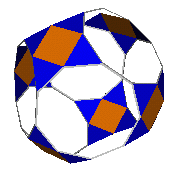
Enneagonal and Hendecagonal Near Misses
Near-miss polyhedra, convex or otherwise, which contain enneagonal (and in the last example) hendecagonal faces.
These polyhedra are also presented as 'Stress Maps', a bespoke form of VRML model for showing distortion in such models. More information on Stress Maps and distortion statistics is available here.
This convex "enneagonal polyhedron" with octahedral symmetry is a Johnson Solid Near Miss. It has perfectly regular enneagons in the face planes of an octahedron, the squares are also regular but have a side length of only 0.96, this makes the triangles slightly isosceles. (combo), (stress map). Distortion (E=1.19, P=1.68, A=159°). Discoverer: Unknown.
9-9-3 Acrohedron
The above polyhedron with icosahedral symmetry contains examples of the unsolved 9-9-3 acron (see 'acrohedra'). Most of the distortion is contained in the diagonals of the enneagons. Stress Map. Distortion (E=0.119, P=2.63, A=431°). Discoverer: Ulrich Mikloweit 2006.
As something of an aside, above are two facetings of Ulrich's 9-9-3 near miss acrohedron. The left image shows a rhombified faceting containing enneagrams {9/2}, pentagrams and square faces. The right image shows a rhombified faceting containing great-enneagrams {9/4}, pentagons and square faces.
9-6-3 Acrohedron
The above polyhedron with tetrahedral symmetry contains examples of the unsolved 9-6-3 acron (see 'acrohedra'). The enneagons are regular, but the triangle-hexagon edge lengths are around 1.13. Stress Map. Distortion (E=1.65, P=3.44, A=223°). Discoverer: Robert Webb 2006.
9-3-5-3 Acrohedron
The above convex polyhedron with icosahedral symmetry contains examples of the unsolved 9-9-3 and 9-3-5-3 acrons (see 'acrohedra'). The enneagons are regular, but the pentagon edge lengths are around 1.2, making it a rather 'far miss'. Stress Map. Distortion (E=12.1, P=18.6, A=1657°). Discoverer: Robert Webb 2006.
Hendecagonal Polyhedron
In similar fashion to the top polyhedron on this page, this "hendecagonal
polyhedron" is based on the snub
cuboctahedron. None of the polygons in the model are not quite regular,
(combo), (stress map).
Distortion (E=0.046, P=2.08,
A=105°). Thanks to Craig Kaplan
for bringing this to my attention. Craig has a page containing this and
similar polyhedra at http://www.cgl.uwaterloo.ca/~csk/projects/nearmisses/
Back: to near-miss
index
Back: to site index